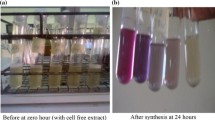Abstract
Sporosarcina ureae was able to grow in the presence of up to 10-ppm L-asparagine complexed gold. However, 10 ppm Au3+ was found to be highly toxic to Sporosarcina ureae, killing 109 bacteria/mL within a few seconds. To compare the effects of these responses on gold mobility, an in vitro bacterial biofilm model was developed to examine the interaction between Sporosarcina ureae and ionic gold or L-asparagine gold complexes in gravity-fed columns. The immobilization of ionic gold was between 80% and 90% over a period of one week. But, as the available cellular reactive sites became saturated, immobilization decreased to 14% within two weeks. In the L-asparagine-gold system, gold immobilization in the cytoplasm occurred at a high rate (80% to 90%) throughout the experiment, with limited toxicity towards Sporosarcina ureae. The bacterial immobilization and detoxification of L-asparagine-complexed ionic gold was associated with a low molecular weight, i.e, <5,000 dalton (atomic mass unit), intracellular protein fraction. This peptide-complexed gold would allow for the continued biogeochemical cycling of gold under ambient (<100°C) surface or near-surface conditions.
Similar content being viewed by others
References
Baker, W.E., 1978, “The role of humic acid in the transport of gold,” Geochimica et Cosmochimica Acta, Vol. 42, pp. 645–649.
Bergeron, M., and Harrison, Y., 1989, “Le transport chimique de l’or dans les environnements de surface: Formation d’un colloïde et complexation organique,” Canadian Journal of Earth Science, Vol. 26, pp. 2327–2332.
Bowell, R.J., Gize, A.P., and Foster, R.P., 1993, “The role of fulvicacid in the supergene migration of gold in tropical rain forest soils,” Geochimica et Cosmochimica Acta, Vol. 57, pp. 4179–4190.
Bradford, M.M., 1976, “A rapid and sensitive method forthe quantitation of microgram quantities of protein utilizing the principle of protein-dye binding,” Analytical Biochemistry, Vol. 72, pp. 248–254.
Craw, D., and Youngson, J.H., 1993, “Eluvial gold placer formation on actively rising mountain ranges, Central Otago, New Zealand,” Sedimentary Geology, Vol. 85, pp. 623–635.
Fedoseyeva, V.l., Fedoseyev, N.F., and Zvonareva, G.V., 1986, “Interaction of some gold complexes with humic and fulvic acids,” Geochemistry International, Vol. 23, pp. 106–110.
Freise, F.W., 1931, “The transportation of gold by organic underground solutions,” Economic Geology, Vol. 26, pp. 421–431.
Giusti, L., 1986, “The morphology, mineralogy, and behavior of “finegrained” gold from placer deposits of Alberta: Sampling and implications for mineral exploration,” Canadian Journal of Earth Science, Vol. 23, pp. 1662–1672.
Goldman, M. and Wilson, D.A., 1977, “Growth of Sporosarcina ureae in defined media,” Federation of European Microbiological Societies Microbiology Letters, Vol. 2, pp. 113–115.
Groen, J.C., Craig, J.R., and Rimstidt, J.D., 1990, “Gold-rich rim formation on electrum grains in placers,” The Canadian Mineralogist, Vol. 28, pp. 207–228.
Hamilton, T.W., Ellis, J., Florence, T.M., and Fardy, J.J., 1983, “Analysis of gold in surface waters from Australian goldfields: An investigation into direct hydrogeochemical prospecting for gold,” Economic Geology, Vol. 78, pp. 1335–1341.
Korobushkina, E.D., Chemyak, A.S., and Mineev, G.G., 1974, “Dissolution of gold by microorganisms and products of their metabolism,” Mikrobiologiya, Vol. 43, pp. 9–54.
Korobushkina, E.D., Mineev, G.G., and Praded, G.P., 1976, “Mechanism of the microbiological process of dissolution of gold,” Mikrobiologiya, Vol. 45, pp. 535–538.
Laemmli, U.K, 1970, “Cleavage of structural proteins during the assembly of the head of bacteriophage T4,” Nature, Vol. 127, pp. 680–685.
Lyalikova, N.N., and Mokeicheva, L.Y., 1969, “The role of bacteria in gold migration in deposits,” Mikrobiologiya, Vol. 38, pp. 805–810.
MacDonald, R.E. and MacDonald, S.W., 1962, “The physiology and natural relationships of the motile, sporeforming Sarcinae,” Canadian Journal of Microbiology, Vol. 8, pp. 795–808.
Mineyev, G.G., 1976, “Organisms in the gold migration-accumulation cycle,” Geochemistry International, Vol. 13, pp. 577–582.
Minter, M. G., Knight, J., and Frimmel, H. E., 1993, “Morphology of Witwatersrand gold grains from the basal reef: evidence for their detrital origin,” Economic Geology, Vol. 88, pp. 237–248.
Santosh, M., Philip, R., Jacob, M. K., and Omana, P. K., 1992, “Highly pure placer gold formation in the Nilambur valley, Wynad gold field, southern India,” Mineralum Deposita, Vol. 27, pp. 336–339.
Southam G., and Beveridge, T. J., 1994, “The in vitro formation of placer gold by bacteria,” Geochimica et Cosmochimica Acta, Vol. 58, pp. 4527–4530.
Southam, G. and Beveridge, T. J., 1996, “The occurrence of bacterially derived sulfur and phosphorus within pseudocrystalline and crystalline octahedral gold formed in vitro,” Geochimica et Cosmochimica Acta, Vol. 60, pp. 4369–4376.
Southam, G., 1998, “Quantification of sulfur and phosphorus within secondary gold rims on Yukon placer gold,” Geology, Vol. 26, pp. 339–342.
Southam, G. 1999, Unpublished observations.
Wilson, A. F., 1984, “Origin of quartz-free gold nuggets and supergene gold found in laterites and soils — A review and some new observations,” Australian J. of Earth Science, Vol. 31, pp. 303–316.
Youngson, J. H., and Craw, D. 1993, “Gold nugget growth during tectonically induced sedimentary recycling, Otago, New Zealand,” Sedimentary Geology, Vol. 84, pp. 71.
Author information
Authors and Affiliations
Rights and permissions
About this article
Cite this article
Southam, G., Fyfe, W.S. & Beveridge, T.J. Immobilization of free ionic gold and L-asparagine-complexed ionic gold by Sporosarcina ureae: The importance of organo-gold complexes in gold mobility. Mining, Metallurgy & Exploration 17, 129–132 (2000). https://doi.org/10.1007/BF03402840
Accepted:
Published:
Issue Date:
DOI: https://doi.org/10.1007/BF03402840




